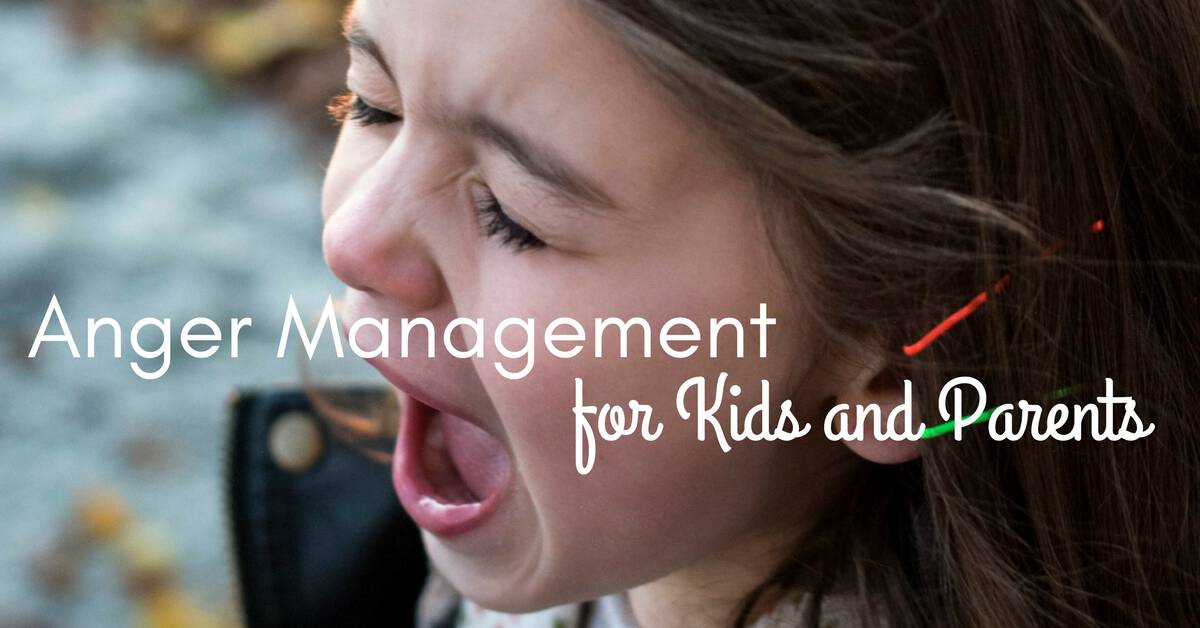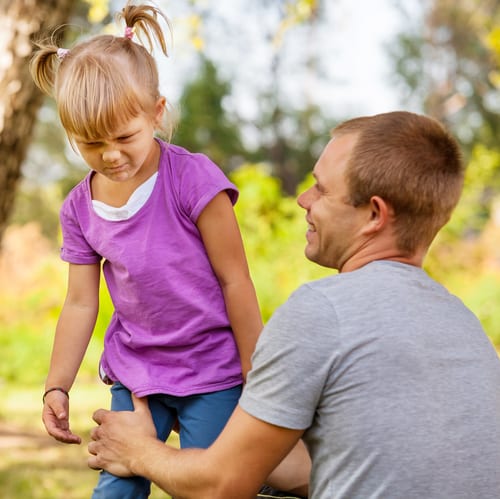
Handling children’s anger can be puzzling, draining, and distressing for adults. As parents, similar feelings stirred up in us as we react and respond to these situations can make this issue even more challenging. We may need to remind ourselves that we didn’t learn the skills necessary to manage our own anger during our youth. In fact, many parents today were conditioned as children to believe that feeling angry was wrong. When we felt or expressed this emotion, we felt guilt and shame. If we let go of this notion, we can better manage our children’s anger and the resulting behavior.
Parents are encouraged to allow their children to experience all feelings (including strong emotions) and recognize and treat them with respect. Our goal is not to repress angry feelings in our children–or ourselves–but rather to accept these emotions and help channel them to constructive ends. A recent study conducted in 2019 found that parents who encourage their kids to express their feelings raise happier children. As they grow older in a household where emotional expression is supported, young adults tend to experience less depression and anxiety.
As you learn how your child manages their feelings, it’s important to realize that their angry outbursts aren’t always a sign of serious problems. It’s more likely that your child hasn’t yet learned how to manage their emotions appropriately. Parents can play a key role here by providing loving support.
To start, be open and honest about your feelings in your kids’ presence. Your children need to see you as a healthy, active adult who appropriately expresses their feelings. As you express your emotions in helpful ways while showing respect for others, you’re also providing your kids with the opportunity to learn to identify feelings of their own.
Additionally, it’s essential to be mindful of your tone of voice around your children. Use appropriate tone, inflection, and volume during most of your interactions with your children, and your kids will learn to use them as well. Remember to keep your voice calm instead of raising your voice when you’re upset.
If you have young children, identify their feelings with them. For very young children, including toddlers, it’s beneficial to label your children’s emotions in their presence. Children six years and younger usually have little understanding of how their emotions function. Use words such as angry, mad, sad, happy, frustrated, etc. A lot of emotional learning can take place in these moments.
- For example, if your three-year-old gets angry at a store and stomps his feet because he wants a toy, get down to his eye level and say something like, “You’re angry at daddy right now because you can’t have that toy.”
- Sometimes, you may find it helpful to tell your child, “It’s okay if you’re mad.” Allowing your child to have these feelings and to voice them can be very validating for them, even if they don’t react that way at the time.
Remember, it’s futile for parents to get frustrated or angry with young children who have a lot to learn about their feelings. By modeling patience, you will teach your child how to maintain their cool even in a frustrating situation. Separate your child’s actions from their emotions and them as people.
To respond effectively to overly aggressive behavior in your child, we need to have some ideas about what may have triggered an outburst in the first place. Anger may be a defense to avoid painful feelings. You may notice that your child or teen feels unmotivated, lacks self-esteem, and feels isolated, or they may show anxiety about situations beyond their control.
Angry defiance may also be associated with feelings of inadequacy, and anger itself may be related to sadness and depression. In childhood, anger and sadness are very close to one another. Another important point to remember is that many of the same feelings that an adult demonstrates as sadness are expressed by children as anger.
Before we look at specific ways to manage aggressive and angry outbursts, several points should be highlighted:
- We should distinguish between anger and aggression in our children. Anger is a temporary emotional state caused by frustration; aggression is often an attempt to hurt a person or to destroy property.
- Anger and aggression don’t have to be dirty words. In looking at aggressive behavior, we must differentiate between behavior that indicates emotional problems and typical child behavior.
- In dealing with angry kids, our actions should be motivated by the need to protect and reach, not by a desire to punish. Parents should show a child they accept their feelings while suggesting other ways to express their emotions. An adult might say, for example, “Let me tell you what some children do in a situation like this…”
- It’s not enough to tell children and teens what behaviors we find unacceptable. We must teach them acceptable ways of coping. Also, it’s crucial to communicate what we expect of them. Contrary to popular opinion, punishment is not the most effective method to teach children what behavior we want from them.

How To Deal With A Child With Anger Issues
Some of the following suggestions for dealing with the angry child were adapted from “The Aggressive Child” by Fritz Redl and David Wineman.
Catch the child being good.
Tell your child what behaviors please you. Respond to positive efforts and reinforce good behavior. An observing and sensitive parent will find countless opportunities during the day to make comments such as:
- “I like the way you come in for dinner without being reminded.”
- “I appreciate that you hung up your clothes even though you were in a hurry to get out to play.”
- “You were very patient while I was on the phone.”
- “I’m glad you shared your snack with your sister.”
- “I like the way you’re able to think of others.”
- “Thank you for telling the truth about what really happened.”
Deliberately ignore inappropriate behavior that can be tolerated.
This doesn’t mean that you should ignore your child, just the behavior. The “ignoring” has to be planned and consistent. Even though this behavior may be tolerated, your child must recognize that it’s inappropriate.
Provide physical outlets and other alternatives.
Children need to have opportunities for physical exercise and movement, both at home and at school.
Manipulate the surroundings.
Aggressive behavior is sometimes unintentionally encouraged when children are placed in tough, tempting situations. Plan the surroundings so that certain things are less apt to happen. Stop a “problem” activity and substitute, temporarily, a more desirable one. Sometimes rules and regulations, as well as physical space, may be too confining.
Use closeness and touching.
Move physically closer to your child to curb their angry impulses. Young children are often calmed by having a parent or other caring adult come close by and who expresses interest in the child’s activities. Children naturally try to involve adults in what they’re doing. Very young children (and emotionally deprived children) seem to need more adult involvement in their interests.
A child about to use a toy or object destructively is sometimes easily redirected by an adult who expresses an interest in having it shown to them. An adult who moves near an older child struggling with a reading assignment may prevent an outburst by saying, “Show me which words are causing you trouble.”
Be ready to show affection.
Sometimes all that is needed for an angry child to regain control is a hug or other show of affection. However, children with severe emotional problems may have trouble accepting physical touch.
Ease tension through humor.
Kidding your child out of a temper tantrum or outburst offers them an opportunity to “save face.” However, it’s essential to distinguish between face-saving humor and sarcasm, teasing, or ridicule.
Appeal directly to your child.
Tell your child how you feel and ask for consideration. For example, a parent may gain a child’s cooperation by saying, “I know that noise you’re making doesn’t usually bother me, but today I’ve got a headache. Could you find something else you’d enjoy doing?”
Explain situations.
Help your child understand the cause of a stressed situation. We often fail to realize how quickly young children can begin to behave appropriately once they know the cause of their frustration.
Use physical restraint only if necessary.
Occasionally, a child may lose control so completely that they have to be physically restrained or removed from the scene to prevent them from hurting themselves or others. Your child should not view physical restraint or removal from the scene as punishment but as a means of saying, “You can’t do that.” It’s imperative during stressful situations such as these that parents control their own emotions to model appropriate ways to manage anger.
Encourage children to see their strengths as well as their weaknesses.
Help your kids to see that they can reach their goals.
Use positive reinforcement.
Providing immediate positive reinforcement when your child manages their feelings appropriately will make a big difference in how they learn to express their emotions. Emotional management will often manifest itself in appropriate behavior.
- Smile and say something like, “Sarah, I like the way you sat so still in the grocery cart. You did a great job!”
- When offering positive comments, state your child’s name and maintain eye contact with them. This will help reinforce positive behavior.
Say “NO!”
Say “no” to your child when appropriate. Limits should be clearly explained and enforced. Children should be free to function within those limits.
For example, if your young child gets frustrated or angry and throws a toy that could hurt other children, you can say, “No, you can’t throw toys. Throwing toys isn’t okay.”
Tell your child that you accept their angry feelings but offer positive suggestions for expressing them. Teach your children to put their angry feelings into words rather than fists.
Build a positive self-image.
Encourage your kids to see themselves as both valued and valuable people.
Use punishment cautiously.
There is a fine line between discipline that is hostile toward a child and discipline that is educational. DO NOT use physical punishment. Use time-outs instead.
Model appropriate behavior.
Parents should be aware of the powerful influence of their actions on their child’s or group’s behavior.
Teach children to express themselves verbally.
Talking helps a child to gain self-control and thus reduces acting out behaviors. Encourage your child to say, for example, “I don’t like that you took my pencil. I don’t feel like sharing right now.”
The Role of Discipline
Poor discipline involves punishment, which is unduly harsh and inappropriate, and it’s often associated with verbal ridicule and attacks on the child’s integrity. As one fourth-grade teacher put it: “One of the most important goals we strive for as parents, educators, and mental health professionals is to help children develop respect for themselves and others.”
As a parent, one of the most significant lessons you’ll ever teach your children is how to identify and appropriately express their feelings. While arriving at this goal takes years of patient practice, it’s a necessary process in which parents, teachers, and all caring adults can play a crucial and exciting role. We must see children as worthy human beings and be sincere in interacting with them to accomplish this.
Adapted from “The Aggressive Child” by Luleen S. Anderson, Ph.D. published by the Children’s Bureau, ACYF, DHEW. (Reprinting permission unnecessary.)

